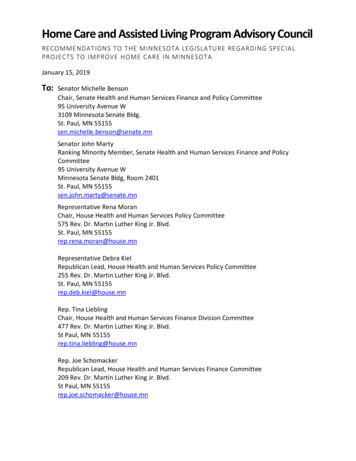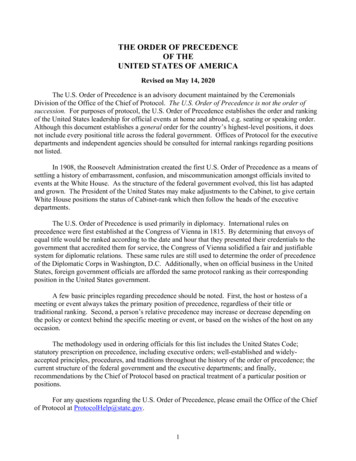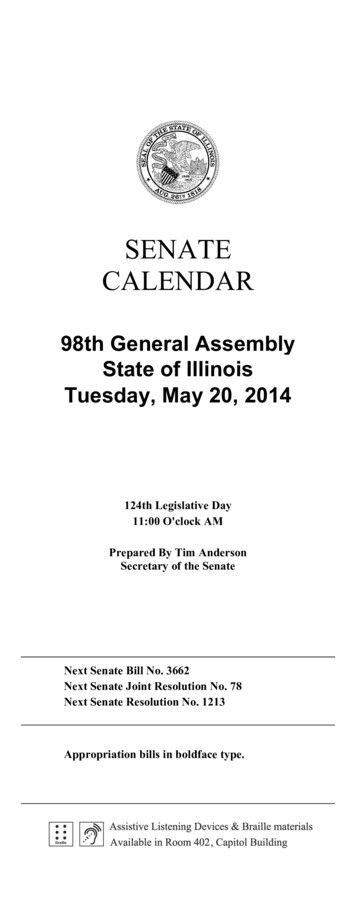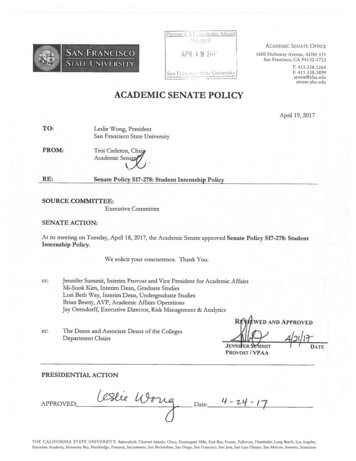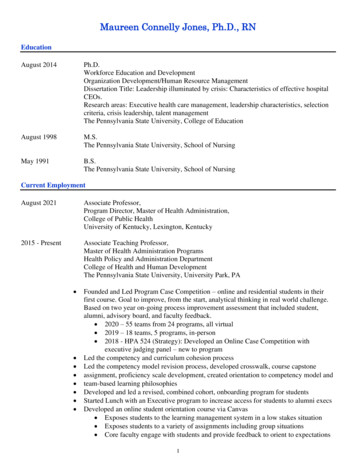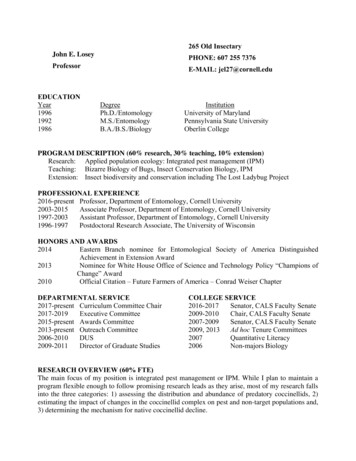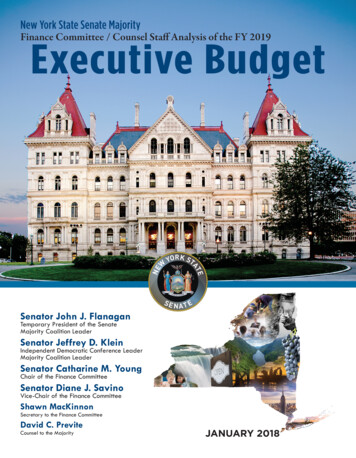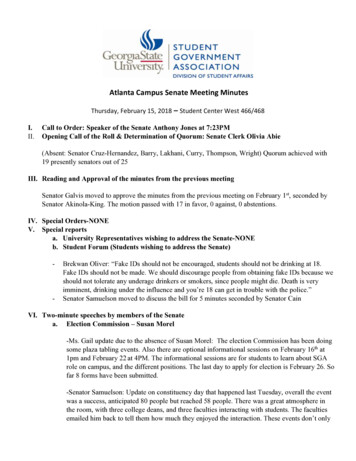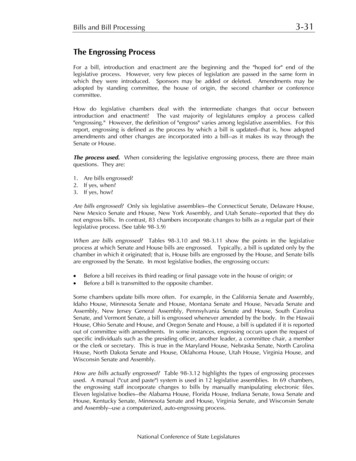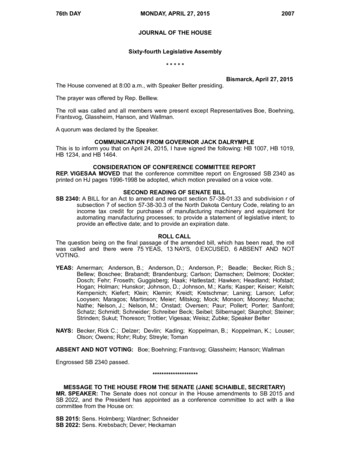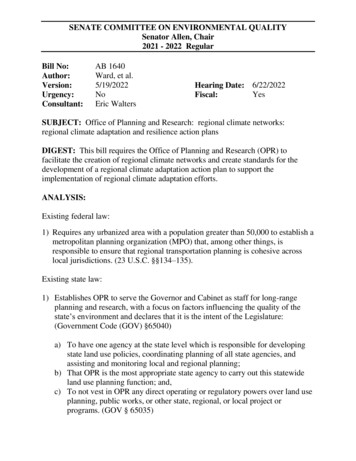
Transcription
SENATE COMMITTEE ON ENVIRONMENTAL QUALITYSenator Allen, Chair2021 - 2022 RegularBill No:Author:Version:Urgency:Consultant:AB 1640Ward, et al.5/19/2022NoEric WaltersHearing Date: 6/22/2022YesFiscal:SUBJECT: Office of Planning and Research: regional climate networks:regional climate adaptation and resilience action plansDIGEST: This bill requires the Office of Planning and Research (OPR) tofacilitate the creation of regional climate networks and create standards for thedevelopment of a regional climate adaptation action plan to support theimplementation of regional climate adaptation efforts.ANALYSIS:Existing federal law:1) Requires any urbanized area with a population greater than 50,000 to establish ametropolitan planning organization (MPO) that, among other things, isresponsible to ensure that regional transportation planning is cohesive acrosslocal jurisdictions. (23 U.S.C. §§134–135).Existing state law:1) Establishes OPR to serve the Governor and Cabinet as staff for long-rangeplanning and research, with a focus on factors influencing the quality of thestate’s environment and declares that it is the intent of the Legislature:(Government Code (GOV) §65040)a) To have one agency at the state level which is responsible for developingstate land use policies, coordinating planning of all state agencies, andassisting and monitoring local and regional planning;b) That OPR is the most appropriate state agency to carry out this statewideland use planning function; and,c) To not vest in OPR any direct operating or regulatory powers over land useplanning, public works, or other state, regional, or local project orprograms. (GOV § 65035)
AB 1640 (Ward)Page 2 of 92) Requires OPR to adopt and periodically revise the State General PlanGuidelines for the preparation and content of general plans for all cities andcounties in California, and: (GOV §65040.2)a) Requires local jurisdictions to include climate vulnerability and adaptationconsiderations in their general plan updates. (GOV §65302)3) Establishes a technical advisory council (TAC) to support OPR by providingscientific and technical support and to facilitate coordination among state,regional, and local agency efforts to adapt to the impacts of climate change.(Public Resources Code (PRC) §71358)4) Establishes the Integrated Climate Adaptation and Resilience Program(ICARP), administered by OPR, to coordinate regional and local efforts withstate climate adaptation strategies to adapt to the impacts of climate change.Requires ICARP to: (PRC §71354)a) Pursue an emphasis on climate equity across sectors and strategies thatbenefit both greenhouse gas (GHG) emissions reductions and adaptationefforts;b) Work with and coordinate local and regional efforts for climate adaptationand resilience;c) Assist the Office of Emergency Services (OES)—in coordination with theCalifornia Natural Resources Agency (CNRA)—with coordinating regularreviews and updates to the Adaptation Planning Guide (APG); and,d) Maintain a continued data clearinghouse on climate change and climateadaptation for the purposes of facilitating educated state and local policydecisions.5) Requires CNRA to, by July 1, 2017 and every three years thereafter, update theSafeguarding California Plan, and as part of the update, to coordinate withother state agencies to identify a lead agency or group of agencies to leadadaptation efforts in each sector, and dictates that the updates include: (PRC§71153)a) Vulnerabilities to climate change by sector, as identified by the lead agencyor group of agencies, and regions, including, at a minimum, the followingsectors: water, energy, transportation, public health, agriculture, emergencyservices, forestry, biodiversity and habitat, ocean and coastal resources;and,i)Priority actions needed to reduce risks in those sectors, as identifiedby the lead agency or group of agencies.
AB 1640 (Ward)Page 3 of 9This bill:1) Defines terms for the purposes of the sections created by this bill, including butnot limited to:a) “Eligible entity” to mean an extensive list of local, regional, tribal, or stateorganizations, including but not limited to a city, county, regional climatecollaborative, regional member of the Alliance of Regional Collaborativesfor Climate Adaptation, or nonprofit organization, among others;b) “Regional climate network” to mean a group of eligible entities whosejurisdictions are located in the same region and whose combinedjurisdiction enhances their effectiveness in responding to climate risks; andc) “Vulnerable community” to mean a community with heightened risk andincreased sensitivity to climate change that has less capacity and fewerresources to cope with, adapt to, or recover from climate impacts.2) Requires OPR, through ICARP, to publish guidelines on how eligible entitiesmay establish regional climate networks, as specified.3) Permits eligible entities to establish and participate in a regional climatenetwork—provided they notify OPR in writing first—and to develop a regionalclimate adaptation and resilience action plan.4) Requires OPR to provide technical assistance facilitating the formation of aregional climate network.5) Specifies the activities regional climate networks may participate in, includingbut not limited to:a) Developing and implementing regional climate adaptation and resilienceaction plans;b) Facilitating the exchange of best practices and other information betweenstakeholders and regions;c) Support coordination and capacity building;d) Administering grants;e) Apply for grants from federal and state agencies;f) Enter into and perform contracts;g) Enter into joint power agreements;h) Hire and compensate staff; andi) Establish direct governance procedures and policies, as specified.Background
AB 1640 (Ward)Page 4 of 91) Adapting to climate risks in California. California is particularly susceptible tothe harmful effects of climate change, including an increase in extreme heatevents, drought, wildfire, sea level rise, and more. According to the FourthCalifornia Climate Change Assessment, by 2100, the average annual maximumdaily temperature is projected to increase by 5.6-8.8 F, water supply fromsnowpack is projected to decline by two-thirds, the average area burned inwildfires could increase by 77%, and 31-67% of Southern California beachesmay completely erode without large-scale human intervention, all underbusiness as usual and moderate GHG reduction pathways.Adaptation can help safeguard against some of the worst impacts, costs, andrisks associated with climate change. While climate change is a global issue, itis felt on a local scale. Cities, counties, and other sub-national jurisdictions aretherefore at the frontline of adaptation. In the absence of national orinternational climate policy direction, cities and local communities around theworld have been focusing on solving their own climate problems.Adaptation is especially important for vulnerable and disadvantagedcommunities. In 2018, ICARP published a resource guide called DefiningVulnerable Communities in the Context of Climate Adaptation. The guidedefines vulnerable communities as those that “experience heightened risk andincreased sensitivity to climate change and have less capacity and fewerresources to cope with, adapt to, or recover from climate impacts. Thesedisproportionate effects are caused by physical (built and environmental),social, political, and/or economic factor(s), which are exacerbated by climateimpacts. These factors include, but are not limited to, race, class, sexualorientation and identification, national origin, and income inequality.” Peopleliving in poverty, tribal communities, immigrants and the elderly are some ofthe groups expected to suffer disproportionately from problems caused by achanging climate. While affluent Californians have resources to shieldthemselves from some of climate change’s impacts, many impoverishedcommunities face threats that are intensified by climate change. For example,they frequently live in areas already vulnerable to pollution and naturaldisasters, yet may lack insurance and other economic means to recover fromhealth problems or disasters. Investing in adaptation efforts in vulnerable anddisadvantaged communities can improve public health, quality of life, andeconomic opportunity in California’s most burdened populations.2) Existing adaptation strategies. California’s adaptation efforts can be tracedback to 2008, when Governor Schwarzenegger ordered CNRA, through theClimate Action Team, to coordinate with local, regional, state, federal, public,
AB 1640 (Ward)Page 5 of 9and private entities to develop the state’s Climate Adaptation Strategy in orderto assess California’s vulnerability to climate change impacts and outlinesolutions that can be implemented to promote resiliency (EO S-13-08). Thestate’s Climate Adaptation Strategy, released in 2009, proposes acomprehensive set of recommendations designed to inform and guideCalifornia decision makers as they begin to develop policies that will protectthe state, its residents, and its resources from a range of climate changeimpacts.a) Safeguarding California. In July of 2014, CNRA released an update to theCalifornia Climate Adaptation Strategy called Safeguarding California:Reducing Climate Risk. This is the state's roadmap for everything stateagencies are doing and will do to protect communities, infrastructure,services, and the natural environment from climate change impacts.Safeguarding California primarily covers state agencies’ programmatic andpolicy responses across different policy areas, but it also discusses theongoing related work with coordinated local and regional adaptation actionand developments in climate impact science.b) Integrated Climate Adaptation and Resilience Program. SB 246(Wieckowski, Chapter 606, Statutes of 2015) established ICARP withinOPR to develop a cohesive and coordinated response to the impacts ofclimate change across the state. They coordinate tools, resources, andtechnical assistance to local and regional governments to aid in theiradaptation and resilience planning. ICARP has multiple legs, including theTechnical Advisory Council (TAC), which is made up of representativesfrom state agencies, local, regional, and tribal governments, non-profits,academia, and the private sector to support OPR in its goal to facilitatecoordination among state, regional and local adaptation and resiliencyefforts, with a focus on opportunities to support local implementationactions. Another leg is the adaptation clearinghouse, an online database foradaptation tools and examples of adaptation projects. The database can besearched by locality or climate impact.c) General Plans. A General Plan is each local government’s blueprint formeeting the community’s long-term vision for the future. SB 379 (Jackson,Chapter 608, Statutes of 2015) requires all cities and counties to includeclimate adaptation and resiliency strategies in the Safety Elements of theirGeneral Plans beginning in 2017. OPR updates the General PlanGuidelines and provides technical advice to help draft and update GeneralPlans.
AB 1640 (Ward)Page 6 of 93) Climate adaptation regions. California is a sprawling state with a variety oflandscapes, climates, population densities, and adaptation needs. The impactsof climate change will also be variable across the state and so will theadaptation needs. Several regions and entities to provide regional guidanceexist already:a) Fourth Climate Change Assessment. California’s Fourth Climate ChangeAssessment breaks down the state into 9 regions: North Coast, CentralCoast, San Francisco Bay Area, Los Angeles, San Diego, SacramentoValley, Inland Deserts, San Joaquin Valley, and Sierra Nevada. Separatereports were included for each region, in part because the vast majority ofadaptation planning and implementation happen at local and regionalscales. Each report provides a summary of relevant climate impacts andadaptation solutions for a region of the state.b) Metropolitan Planning Organizations. Federal law requires that anyurbanized area with population of at least 50,000 be guided and maintainedby a regional entity known as a MPO. Eighteen MPOs are designated inCalifornia, accounting for approximately 98% of the state’s population. SB375 (Steinberg, Chapter 728, Statutes of 2008) details specific roles forCalifornia MPOs, expanding their role in regional planning and developingsustainable community strategies.c) Regional collaboratives. Seven regional climate collaboratives havealready been formed and are members of the Alliance of RegionalCollaborative for Climate Adaptation (ARCCA): the Bay Area ClimateAdaptation Network (BayCAN), the Capital Region Climate ReadinessCollaborative (CRC), the Central Coast Climate Collaborative (4C), theLos Angeles Regional Collaborative for Climate Action and Sustainability(LARC), the North Coast Resource Partnership (NCRP), the San DiegoRegional Climate Collaborative (SDRCC), and the Sierra ClimateAdaptation & Mitigation Partnership (Sierra CAMP). The inland empirealso has a climate adaptation network called the Inland Southern CaliforniaClimate Collaborative (ISC3).These collaboratives encompass 80% of the state’s population. Memberorganizations of these networks include city governments, countygovernments, regional and state government agencies, regional planningauthorities, utility companies and districts, non-profit organizations,community-based organizations, tribal governments, school districts,academic institutions, and more. Each collaborative functions differently,however they generally serve their members by fostering learning
AB 1640 (Ward)Page 7 of 9networks, bringing in outside resources, connecting member organizations,and helping them identify adaptation projects and funding sources.Comments1) Purpose of Bill. According to the author, “Currently there are various climatechange collaboratives and authorities throughout the state that have beenestablished at the local level. While each collaborative/authority is working toaddress climate change issues in their particular region, there needs to beconsistent best practices or standards available across all areas of the state. AB1640 seeks to address this by requiring the Office of Planning and Research toadopt guidelines for the establishment of Regional Climate Networks.”2) Same foundation, different solutions. As described in the background, manyareas in California already have established regional climate planningcollaboratives to address the mounting impacts of climate change. However,their basis and structures vary; the San Diego Regional Climate Collaborativewas created as a non-profit, the Sonoma Regional Climate Protection Authoritywas created in statute, and the Bay Area Climate Adaptation Network is acollaboration of local governments. There are also areas in the state,particularly the Central Valley that do not have a regional climate collaborativeor authority. There is no consistency with how existing collaboratives havebeen created.Given that regions are working on regional adaptation planning, it is importantto provide statutory authority to establish Regional Climate Networks so thereis consistency and accountability as state (and potentially federal) funds flowthrough these Networks. By establishing a clear statutory foundation, RegionalNetworks can build upon clear, uniform authorities to develop the plans andactions that are needed in their specific area.3) Third time’s the charm? This committee has previously heard and passed outtwo similar bills, AB 897 (Mullin, 2021) and AB 2621 (Mullin, 2020). Bothbills subsequently were held on suspense in the Senate AppropriationsCommittee.Language in AB 1640 mirrors language from AB 897 with respect toestablishing Regional Climate Networks. They both require OPR to developand publish on its website guidelines regarding how eligible entities mayestablish regional climate networks and how governing boards may beestablished within regional climate networks. The major difference between thetwo bills is that last year’s AB 897 also established criteria for development of
AB 1640 (Ward)Page 8 of 9regional adaption plans that this bill does not include. Criteria for developmentof regional adaptation plans, was instead included in budget trailer billlanguage from SB 170 (Chapter 240, Statutes of 2020).In the two years since Assemblymember Mullin introduced AB 2621, the statehas taken more actions towards establishing regional climate collaboratives, aswell as guiding and funding regional adaptation plans. This bill aligns withcurrent regional adaptation efforts already underway, while also establishing aclear path to establish, disseminate, and follow best practices going forward.Related/Prior LegislationAB 897 (Mullin, 2021) would have would directed OPR to facilitate the creation ofregional climate networks and create standards for regional climate adaptation andresilience action plans to support the implementation of regional climate adaptationeffort. This bill was held on suspense in the Senate Appropriations Suspense File.AB 2621 (Mullen, 2020) would have required, on or before January 1, 2022, OPRto develop guidelines that establish standards for how a network should develop aregional climate adaptation action plan to gain the approval of the OPR. RequiredOPR to make recommendations on improving state support for regional climatenetwork. This bill was held on suspense in the Senate Appropriations Committee.SOURCE:AuthorSUPPORT:Association of California Water Agencies (ACWA)CA Association of Local Agency Formation CommissionsCalifornia Association of Resource Conservation DistrictsCalifornia Council of Land TrustsCalifornia Environmental Voters (formerly Clcv)California Special Districts AssociationCivicwell (formally the Local Government Commission)Edison International and Affiliates, Including Southern California EdisonEncinitas; City ofMidpeninsula Regional Open Space DistrictMonterey; County ofSan Diego Association of GovernmentsSan Diego Green New Deal AllianceSan Diego; City ofSandiego350
AB 1640 (Ward)Page 9 of 9OPPOSITION:None received-- END --
assisting and monitoring local and regional planning; b) That OPR is the most appropriate state agency to carry out this statewide . network—provided they notify OPR in writing first—and to develop a regional climate adaptation and resilience action plan. 4) Requires OPR to provide technical assistance facilitating the formation of a .
